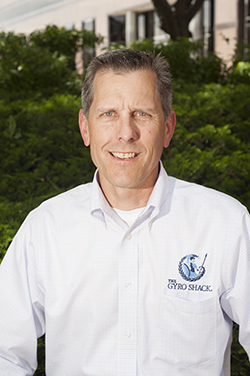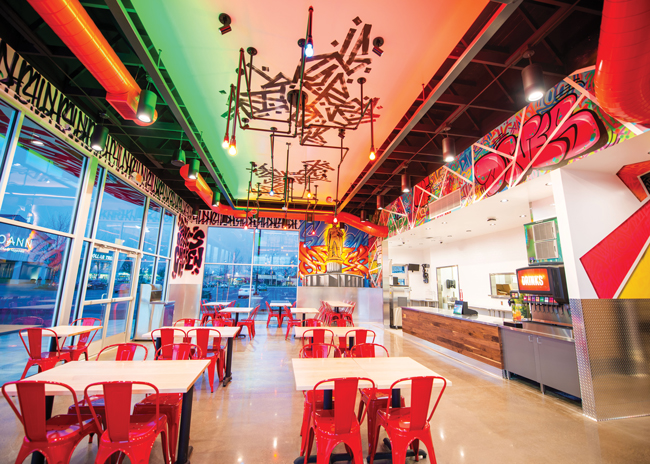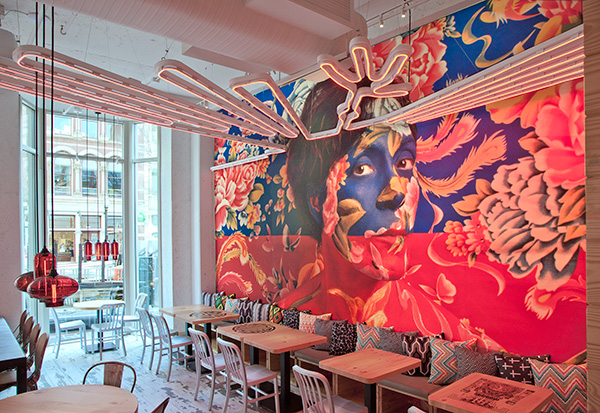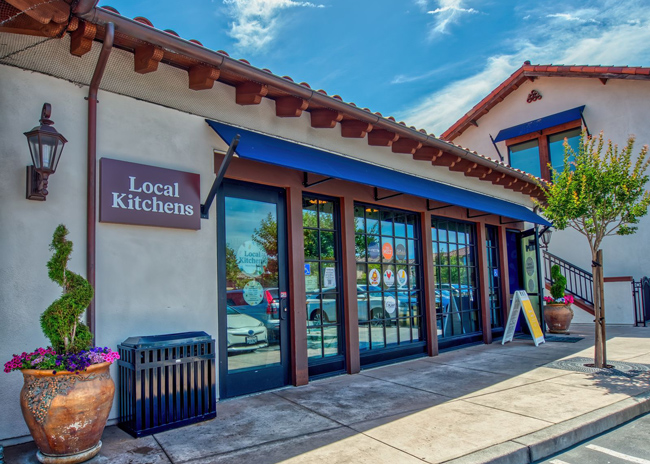 Doug MillerIn 2009, the first Gyro Shack opened in Boise, Idaho, operating out of less than 200 square feet.
Doug MillerIn 2009, the first Gyro Shack opened in Boise, Idaho, operating out of less than 200 square feet.
A second diminutive store followed, but by this summer, the budding brand will be operating three distinct models: a tiny store model, an urban store model of around 1,000 square feet and a full-size QSR prototype of close to 2,000 square feet. The chain expects to have eight locations by year’s end. CEO Doug Miller believes the versatility of this QSR brand will be the secret to its success.
How big are the first stores you opened?
DM: Our first store is less than 200 square feet and opened in a former coffee kiosk with a double drive-thru. Our second is 380 square feet, also in a coffee kiosk with a double drive-thru, with a walk-up window and a tiny patio with two benches.
Then you decided to get slightly bigger?
DM: Yes. We opened our first urban location in downtown Boise last November. It’s 780 square feet with 20 seats and bar seating. The kitchen is right there, and people get to watch their gyro being prepared.
What are the advantages, besides more space, of this urban location?
DM: The urban location has allowed us to step out of our comfort zone of double drive-thrus and move into the dine-in world. We are able to determine new product flow and test some grab-and-go items in a downtown environment.
Tell us about your largest yet, which will open in the late summer less than 100 yards from your current location in Boise.
DM: At our store in Boise, we are bursting at the seams. It’s nothing to see seven cars backed up in each line, and we [end up] losing sales. We’re going to take over an old Pizza Hut just across the parking lot, so we’ll see what this brand can do. It will be the biggest yet — 1,800 square feet including a patio with additional seating, so we’ll have more than 50 seats. It’ll have a double drive-thru with one pickup window, and we’ll run catering out of there, too.
Will all stores be in former restaurant spaces?
DM: No. I plan to open one on a currently empty lot in Meridian, Idaho. This location will be a blend of the drive-thru and urban locations. We will provide indoor and outdoor seating, but it will not be fashioned to accommodate long dwell times. Our brand is simple and relies on quick turns both in the drive-thru and dine-in.
What are some of the challenges of going into a former restaurant operation and redesigning it for Gyro Shack?
DM: It’s not a whole lot different from going into an existing space of any brand and redesigning the space and stripping out what was there and putting in what we do. The things that are imperative are a hood — or can we install one — and a grease trap. If we have to put these in, we have to make sure, for example, that there’s enough space in the attic of these small places to punch through and provide ventilation.
Where do you think the brand will be most successful?
DM: I truly believe it’s going to be the one we’re going to build in Meridian. It will have a drive-up, indoor and outdoor seating, and walk-up ordering because it’s a larger footprint, and it’ll be more inviting for people to come and eat in but will have something for people who want to get food on the fly. That 950- to 1,000-square-foot size is the scenario I think long-term is where we fit because we’re meeting everybody’s needs.
Did you specifically design your menu with the small space in mind?
DM: Our menu is not as complex as one might think. We have gyros, then added flavor profiles. It’s all off the premise of that base gyro.
How do you design your tiny stores for maximum efficiency?
DM: We have the smallest flat-top grills, rotisseries and kitchen sinks that code will allow. We have a Pepsi machine and a small one-door refrigerator, and we store paper goods and other dry items up high.
It goes back to the simplified menu. Our menu is very condensed, and we’re able to prep everything in a 2-foot-by-2-foot counter area. And since it’s a drive-thru, you don’t need things like people cleaning tables, emptying the trash or bathrooms for customers. We also limit the equipment we need because our menu is so small.
What does it mean for Gyro Shack that you don’t have a cookie-cutter prototype?
DM: We’re really excited about the next phase of where the brand will go. Each time we open a new store, we find ourselves tweaking the model just a little bit to accommodate. We’ll see if we can be successful in a more traditional QSR environment. By the end of the year, we’re going to know an awful lot more about this brand, and although we might have 10 versions of the prototype, we’ll probably scale back to three basic iterations: the tiny footprint, the urban store of under 1,000 square feet and the larger store of closer to 2,000 square feet. If these larger locations also work, it expands our ability for growth because we’re not limited to the spaces we can go into.
What are the advantages and disadvantages of not having one prototype?
DM: It allows us the flexibility to go into any spaces that come available. On the downside, you’re always having to reconfigure and start over. And, from a pricing perspective, we can’t take advantage of economies of scale. When you don’t have one prototype, it’s hard to go to vendors and try to start getting the economies [of scale] — on chairs, furnishings — of multiple locations. So, we can’t leverage our vendors as effectively as we’d like.
What elements of the design of the prototypes will stay the same for each location?
DM: We will have the same main
branding throughout all of our locations. Athena is our iconic figure, so we picked that Greek goddess and designed and developed the logo with her on it. In every location, we are very food forward and prep food in front of the customer — we don’t have kitchens behind doors. It’s important to have an image, colors and furniture that are consistent.
We recently had an 18-foot-long [Greek-themed] mural painted in our downtown Boise store. It cost $4,000, and we’ll reproduce it in all sorts of ways, and it will be in every restaurant in some shape or form. Our branding firm has digitized it, so other stores can use all of it or just a section of it if they prefer.
Have you changed anything in any of your stores yet based on customer feedback?
DM: Yes. In the urban Boise store, we put a counter with stools along the wall where the mural is. In an area between there and the kitchen, we put in some tabletops, but we found very few people would use the tabletops. I believe it’s because it was fairly tight as people stood there or walked by. It was probably uncomfortable to the consumer to eat their gyro while someone was standing over them. So, we took out the tabletops and changed the counter to a two-sided counter with high stools, and it’s working out much better.



